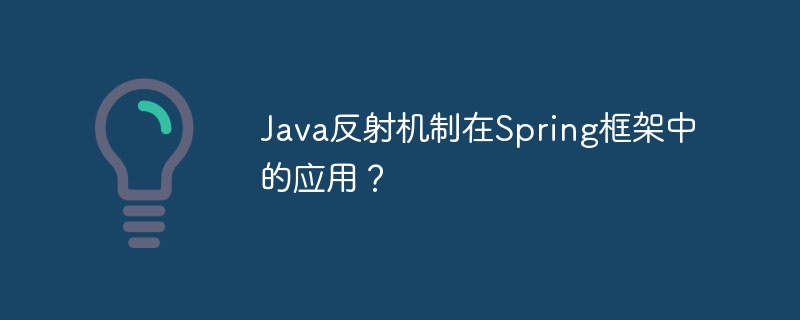Home >Java >javaTutorial >Application of Java reflection mechanism in Spring framework?
Application of Java reflection mechanism in Spring framework?
- 王林Original
- 2024-04-15 14:03:011292browse
The Java reflection mechanism is widely used in the Spring framework for the following aspects: Dependency injection: instantiating beans and injecting dependencies through reflection. Type conversion: Convert request parameters to method parameter types. Persistence framework integration: mapping entity classes and database tables. AspectJ support: intercepting method calls and enhancing code behavior. Dynamic Proxy: Create proxy objects to enhance the behavior of the original object.

Application of Java reflection mechanism in Spring framework
Introduction
Java Reflection is a powerful feature that allows programs to inspect and modify the behavior of classes at runtime. In the Spring framework, the reflection mechanism is widely used in the following aspects:
1. Dependency injection
Spring instantiates beans through reflection and injects dependencies using reflection. This enables loose coupling and code reusability.
// Bean定义
@Service
public class UserService {
private UserRepository userRepository;
// 构造注入
public UserService(UserRepository userRepository) {
this.userRepository = userRepository;
}
}
// 测试方法
@Test
public void testUserService() {
UserService userService = new UserService(Mockito.mock(UserRepository.class));
}2. Type conversion
Spring can use reflection to convert request parameters into method parameter types. This simplifies parameter handling and improves code readability.
@Controller
public class MyController {
@RequestMapping("/user/{id}")
public User getUser(@PathVariable("id") Long id) {
return userRepository.findById(id);
}
}3. Persistence framework integration
When Spring is integrated with persistence frameworks (such as Hibernate and JPA), the reflection mechanism is used to map entity classes and database tables. This automatically handles object-relational mapping.
// Hibernate配置
@Configuration
public class HibernateConfig {
@Bean
public LocalSessionFactoryBean sessionFactory() {
LocalSessionFactoryBean sessionFactory = new LocalSessionFactoryBean();
sessionFactory.setDataSource(dataSource());
sessionFactory.setPackagesToScan("com.example.domain");
return sessionFactory;
}
}4. AspectJ support
When Spring is integrated with AspectJ, the reflection mechanism is used to intercept method calls and enhance code behavior. This provides convenient scalability and cross-cutting concerns.
// Aspect实现
@Aspect
public class LoggingAspect {
@Before("execution(* com.example.service.*.*(..))")
public void logMethodCall(JoinPoint joinPoint) {
logger.info("Method {} is called with arguments {}",
joinPoint.getSignature().getName(), joinPoint.getArgs());
}
}5. Dynamic proxy
Spring uses Java dynamic proxy to create proxy objects and enhance the behavior of the original object. This is widely used to implement AOP and transaction management.
// 动态代理工厂
@Bean
public JdbcTemplate jdbcTemplate() {
JdbcTemplate jdbcTemplate = new JdbcTemplate(dataSource());
DataSourceTransactionManager transactionManager =
new DataSourceTransactionManager(dataSource());
return (JdbcTemplate) Proxy.newProxyInstance(
JdbcTemplate.class.getClassLoader(),
new Class[] { JdbcTemplate.class },
new TransactionAwarePersistenceManagerFactoryPostProcessor(transactionManager));
}The above are just a small part of the many applications of Java reflection mechanism in the Spring framework. By understanding these applications, developers can take full advantage of reflection mechanisms to improve code reusability, flexibility, and functionality.
The above is the detailed content of Application of Java reflection mechanism in Spring framework?. For more information, please follow other related articles on the PHP Chinese website!

